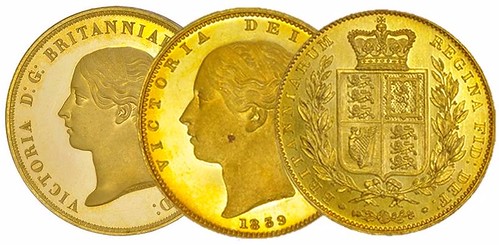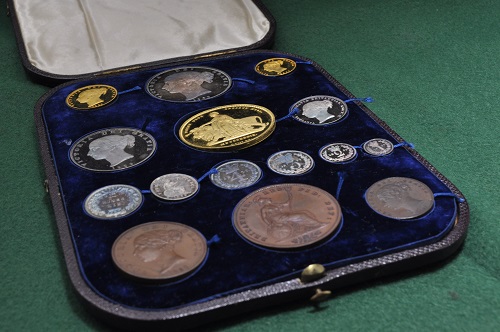
PREV ARTICLE
NEXT ARTICLE
FULL ISSUE
PREV FULL ISSUE
AN 1839 VICTORIA PROOF SET
The September 2015 Baldwin's Newsletter has a few interesting articles including a piece on the Prospero Library mentioned earlier in
this issue, and one on coins of Mary Queen of Scots. But I thought I'd share this one about predecimal British coins and featuring an
amazing 1839 proof set. -Editor
On September 9 this year, the UK's current Queen, Elizabeth II, became the longest reigning Monarch these shores have ever known, surpassing the record previously held by her great-great-grandmother, Victoria. 63 years is rather a long time to sit atop a throne, and there have inevitably been a few world events and changes since a young Princess Elizabeth ascended the steps at Westminster Abbey to claim her new title. As far as the numismatist is concerned, however, arguably the most important event to happen during her reign was the advent of decimalisation. The move, in 1971, was controversial at the time (people are resistant to 'change'), and had the effect of moving a long-standing series of coins (hands-up who remembers paying for things with a florin?) from the pockets of nylon and crimplene flared trousers and into the realms of the collectors. Many of the coins from pre-1971 are, of course, still available in significant numbers. There are, for example, plenty of old farthings hiding in attics and at the bottom of grandmother's purses. Anyone with a metal detector and a half-decent reference book has found a sixpence or two upon the moor. And the reason for these coins' profligacy is pretty clear - there were a lot of them, produced and circulated in abundance, used on a daily basis. 

The rarity of these coins, then, is understandable. And, as with the majority of coins of this nature, the older the coin the more the condition varies. When a complete set appears, then, especially one that is in virtually mint condition, the occasion calls for some fanfare. 
The Victoria Proof Set from 1839 that appears in our auction on 24 September at our London Offices is one such set. Without a doubt the finest of its type ever to have passed through our saleroom, it has been graded the highest ever by the NGC (Numismatic Guarantee Corporation), and also carries a remarkable provenance, with an attached label demarking the last time it was sold at auction - on April 10 1856 at Sotheby's, where it sold for a magnificent £10 and 10 shillings - around £465 in today's money. Today, we reckon its worth a bit more. Proof sets are not uncommon, especially sets post-decimalisation. Gone may be the days when a first class degree in mathematics was required in order to work out your change, but so, arguably, has a little of the romanticism that comes with a pocket full of florins and sixpences. Whether the coinage of today (not just in the UK, but the euro, the dime and the dollar fall into this category as well) will have the same level of collectability in the future is a matter of some debate. Queen Elizabeth II's reign has seen so much significant change in the world that it is not unreasonable to predict that we may well see such coinage consigned to the collecting cabinets in the future (Apple Pay, anyone?). Until that happens, we will continue to marvel at, and to covet, that which has come before. To visit the Baldwin's web site, see:
Wayne Homren, Editor The Numismatic Bibliomania Society is a non-profit organization promoting numismatic literature. See our web site at coinbooks.org. To submit items for publication in The E-Sylum, write to the Editor at this address: whomren@gmail.com To subscribe go to: https://my.binhost.com/lists/listinfo/esylum All Rights Reserved. NBS Home Page Contact the NBS webmaster 
|